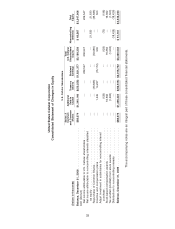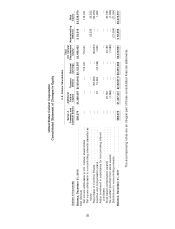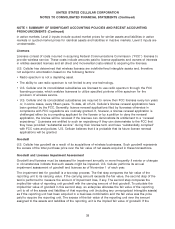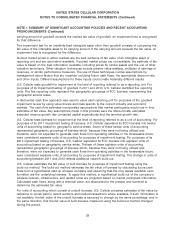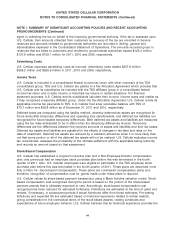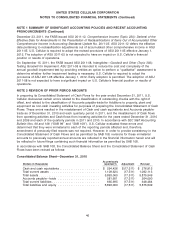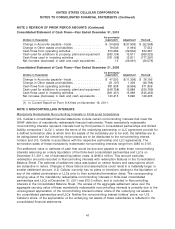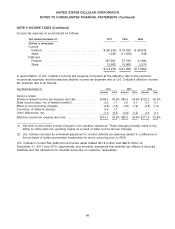US Cellular 2011 Annual Report Download - page 49
Download and view the complete annual report
Please find page 49 of the 2011 US Cellular annual report below. You can navigate through the pages in the report by either clicking on the pages listed below, or by using the keyword search tool below to find specific information within the annual report.UNITED STATES CELLULAR CORPORATION
NOTES TO CONSOLIDATED FINANCIAL STATEMENTS (Continued)
NOTE 1 SUMMARY OF SIGNIFICANT ACCOUNTING POLICIES AND RECENT ACCOUNTING
PRONOUNCEMENTS (Continued)
the asset to its estimated fair value. If the carrying value exceeds the estimated fair value (less cost to
sell), an impairment loss is recognized for the difference.
Quoted market prices in active markets are the best evidence of fair value of a tangible long-lived asset
and are used when available. If quoted market prices are not available, the estimate of fair value is
based on the best information available, including prices for similar assets and the use of other valuation
techniques. A present value analysis of cash flow scenarios is often the best available valuation
technique. The use of this technique involves assumptions by management about factors that are
uncertain including future cash flows, the appropriate discount rate, and other inputs. Different
assumptions for these inputs could create materially different results.
Agent Liabilities
U.S. Cellular has relationships with agents, which are independent businesses that obtain customers for
U.S. Cellular. At December 31, 2011 and 2010, U.S. Cellular had accrued $75.3 million and $71.3 million,
respectively, for amounts due to agents. This amount is included in Other current liabilities in the
Consolidated Balance Sheet.
Other Assets and Deferred Charges
Other assets and deferred charges include legal and other charges related to U.S. Cellular’s various
borrowing instruments, and are amortized over the respective term of each instrument. The amounts for
deferred charges included in the Consolidated Balance Sheet at December 31, 2011 and 2010, are
shown net of accumulated amortization of $9.6 million and $11.9 million, respectively.
Asset Retirement Obligations
U.S. Cellular operates cell sites, retail stores and office spaces in its operating markets. A majority of
these sites, stores and office spaces are leased. Most of these leases contain terms which require or
may require U.S. Cellular to return the leased property to its original condition at the lease expiration
date.
U.S. Cellular accounts for asset retirement obligations by recording the fair value of a liability for legal
obligations associated with an asset retirement in the period in which the obligations are incurred. At the
time the liability is incurred, U.S. Cellular records a liability equal to the net present value of the
estimated cost of the asset retirement obligation and increases the carrying amount of the related
long-lived asset by an equal amount. The liability is accreted to its present value over a period ending
with the estimated settlement date of the respective asset retirement obligation. The carrying amount of
the long-lived asset is depreciated over the useful life of the asset. Upon settlement of the obligation, any
difference between the cost to retire the asset and the recorded liability (including accretion of discount)
is recognized in the Consolidated Statement of Operations.
Treasury Shares
Common Shares repurchased by U.S. Cellular are recorded at cost as treasury shares and result in a
reduction of equity. Treasury shares are reissued as part of U.S. Cellular’s stock-based compensation
programs. When treasury shares are reissued, U.S. Cellular determines the cost using the first-in, first-out
cost method. The difference between the cost of the treasury shares and reissuance price is included in
Additional paid-in capital or Retained earnings.
41




